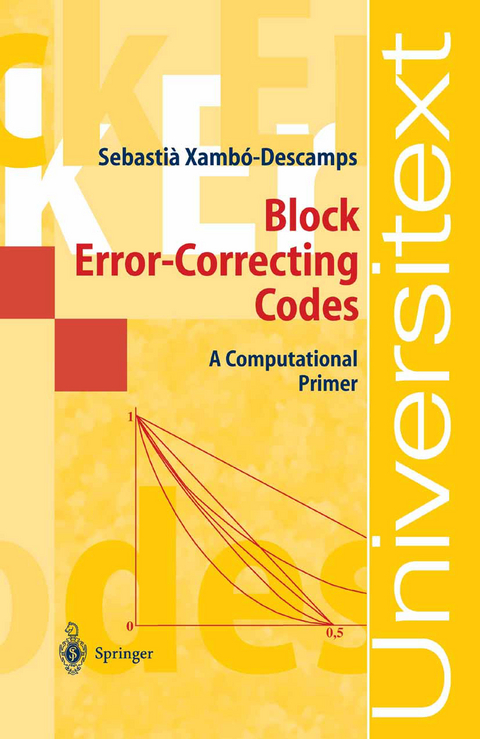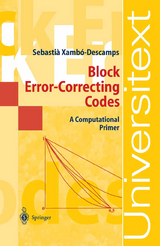Block Error-Correcting Codes
Springer Berlin (Verlag)
978-3-540-00395-3 (ISBN)
Error-correcting codes have been incorporated in numerous working communication and memory systems. This book covers the mathematical aspects of the theory of block error-correcting codes together, in mutual reinforcement, with computational discussions, implementations and examples of all relevant concepts, functions and algorithms. This combined approach facilitates the reading and understanding of the subject.
The digital companion of the book is a non-printable .pdf document with hyperlinks. The examples included in the book can be run with just a mouse click and modified and saved by users for their own purpose.
1 Block Error-correcting Codes.- 2 Finite Fields.- 3 Cyclic Codes.- 4 Alternant Codes.- Index of Symbols.- Alphabetic Index, Glossary and Notes.
From the reviews:
Xambó-Descamps offers a well-written work treating basic ideas and computational practice of error-correcting codes. These codes are ubiquitous in current technology--from bar codes and ISBN numbers to the storage and retrieval of data on space stations and DVDs. Chapters discuss background material on finite fields, cyclic codes, and alternant codes; many important classes of codes are described. Emphasis throughout is on efficient coding and decoding rather than general theory. There are many computational examples, presented in WIRIS, a programming environment similar to computer algebra systems such as Maple and Mathematica. WIRIS is free via the Internet for examining the examples in this book. Coding examples are quite short and easily translated to Mathematica or Maple. Although admirably clear and terse, the book's dense theorem-proof-remark style makes it unlikely to be read by any but the most motivated or talented undergraduates. However, in addition to an appendix (on the features of WIRIS) and an index of symbols, this book has an outstanding and unusual feature: the index is combined with glossary and ancillary notes; each index entry not only offers page references but also carefully defines the concept and sometimes adds other information as well--a well-executed, fabulous resource. Summing Up: Highly recommended. Upper-division undergraduates through faculty. CHOICE
"This book is a very well written computational primer on coding theory. ... Each of the four chapters is very well organized and contains many examples (which can be run with just a mouse click in the freely downloadable online version). The reader will find a concise introduction and a table of 'essential points' to each section and a clearly arranged summary with a set of problems ... . The book can be highly recommended for anyone interested in coding theory and its computational aspects." (D. Burde, Monatshefte Für Mathematik, Vol.145 (4), 2005)
"This textbook on block error-correcting codes is designed for a one-semester course geared towards mathematics, computer-science, and engineering students at the advanced undergraduate level. ... A variety of well-chosen examples illustrate the mathematics presented, which then can be modified and saved by the user. The system there can also be used by students to submit homework electronically and by teachers to test whether the computational implementations run properly; very nice features indeed." (Katherine Roegner, Zentralblatt MATH, Vol. 1050, 2005)
"Coding theory is one of the central fields in computer science, and the present textbook gives a well written and concise introduction for students of mathematics and computer science. The presentation always emphasizes applications, and computational aspects are handled via the java based computer algebra system WIRIS which is available online for free together with the entire book." (S. Teschl, Internationale Mathematische Nachrichten, Issue 197, 2004)
"This book presents a one-semester course in coding theory, meant for third- or fourth-year university students. ... This book has the special feature that at http://www.wiris.com/cc a PDF file of the book is available. ... If you click on any chapter in the book an interactive system called WIRIS/cc is activated which enables you to create your own examples, or to play with existing ones. ... These extras make this book an attractive introduction to the field of coding theory." (Bram van Asch, Mathematical Reviews, 2004 g)
"This book covers the mathematical aspects of the theory of block error-correcting codes together, in mutual reinforcement, with computational discussions, implementations and examples of all relevant concepts, functions and algorithms. This combined approach facilitates the reading and understanding of the subject. The digital companion of the book is a non-printable pdf document freely downloaded fromhttp://www.wiris.com/cc/. The examples included in the book can be run with just a mouse click ... ." (L'ENSEIGNEMENT MATHEMATIQUE, Vol. 49 (3-4), 2003)
"Xambó-Descamps ... offers a well-written work treating basic ideas and computational practice of error-correcting codes. ... this book has an outstanding and unusual feature: the index is combined with glossary and ancillary notes; each index entry not only offers page references but also carefully defines the concept and sometimes adds other information as well--a well-executed, fabulous resource. Summing Up: Highly recommended. Upper-division undergraduates through faculty." (M. Henle, CHOICE, March, 2004)
From the reviews:Xambó-Descamps offers a well-written work treating basic ideas and computational practice of error-correcting codes. These codes are ubiquitous in current technology--from bar codes and ISBN numbers to the storage and retrieval of data on space stations and DVDs. Chapters discuss background material on finite fields, cyclic codes, and alternant codes; many important classes of codes are described. Emphasis throughout is on efficient coding and decoding rather than general theory. There are many computational examples, presented in WIRIS, a programming environment similar to computer algebra systems such as Maple and Mathematica. WIRIS is free via the Internet for examining the examples in this book. Coding examples are quite short and easily translated to Mathematica or Maple. Although admirably clear and terse, the book's dense theorem-proof-remark style makes it unlikely to be read by any but the most motivated or talented undergraduates. However, in addition to an appendix (on the features of WIRIS) and an index of symbols, this book has an outstanding and unusual feature: the index is combined with glossary and ancillary notes; each index entry not only offers page references but also carefully defines the concept and sometimes adds other information as well--a well-executed, fabulous resource. Summing Up: Highly recommended. Upper-division undergraduates through faculty. CHOICE"This book is a very well written computational primer on coding theory. … Each of the four chapters is very well organized and contains many examples (which can be run with just a mouse click in the freely downloadable online version). The reader will find a concise introduction and a table of ‘essential points’ to each section and a clearly arranged summary with a set of problems … . The book can be highly recommended for anyone interested in coding theory and its computational aspects." (D. Burde, Monatshefte Für Mathematik, Vol.145 (4), 2005)"This textbook on block error-correcting codes is designed for a one-semester course geared towards mathematics, computer-science, and engineering students at the advanced undergraduate level. … A variety of well-chosen examples illustrate the mathematics presented, which then can be modified and saved by the user. The system there can also be used by students to submit homework electronically and by teachers to test whether the computational implementations run properly; very nice features indeed." (Katherine Roegner, Zentralblatt MATH, Vol. 1050, 2005)"Coding theory is one of the central fields in computer science, and the present textbook gives a well written and concise introduction for students of mathematics and computer science. The presentation always emphasizes applications, and computational aspects are handled via the java based computer algebra system WIRIS which is available online for free together with the entire book." (S. Teschl, Internationale Mathematische Nachrichten, Issue 197, 2004)"This book presents a one-semester course in coding theory, meant for third- or fourth-year university students. … This book has the special feature that at http://www.wiris.com/cc a PDF file of the book is available. … If you click on any chapter in the book an interactive system called WIRIS/cc is activated which enables you to create your own examples, or to play with existing ones. … These extras make this book an attractive introduction to the field of coding theory." (Bram van Asch, Mathematical Reviews, 2004 g)"This book covers the mathematical aspects of the theory of block error-correcting codes together, in mutual reinforcement, with computational discussions, implementations and examples of all relevant concepts, functions and algorithms. This combined approach facilitates the reading and understanding of the subject. The digital companion of the book is a non-printable pdf document freely downloaded fromhttp://www.wiris.com/cc/. The examples included in the book can be run with just a mouse click … ." (L'ENSEIGNEMENT MATHEMATIQUE, Vol. 49 (3-4), 2003)"Xambó-Descamps … offers a well-written work treating basic ideas and computational practice of error-correcting codes. … this book has an outstanding and unusual feature: the index is combined with glossary and ancillary notes; each index entry not only offers page references but also carefully defines the concept and sometimes adds other information as well--a well-executed, fabulous resource. Summing Up: Highly recommended. Upper-division undergraduates through faculty." (M. Henle, CHOICE, March, 2004)
| Erscheint lt. Verlag | 16.4.2003 |
|---|---|
| Reihe/Serie | Universitext |
| Zusatzinfo | X, 266 p. With online files/update. |
| Verlagsort | Berlin |
| Sprache | englisch |
| Maße | 155 x 235 mm |
| Gewicht | 425 g |
| Themenwelt | Informatik ► Theorie / Studium ► Algorithmen |
| Mathematik / Informatik ► Mathematik ► Wahrscheinlichkeit / Kombinatorik | |
| Schlagworte | algorithms • combinatorics • Communication • error-correcting code • Error-correcting codes • Fehlererkennung • Fehlererkennung / Troubleshooting • finite field • Prime • Symbol |
| ISBN-10 | 3-540-00395-9 / 3540003959 |
| ISBN-13 | 978-3-540-00395-3 / 9783540003953 |
| Zustand | Neuware |
| Haben Sie eine Frage zum Produkt? |
aus dem Bereich




